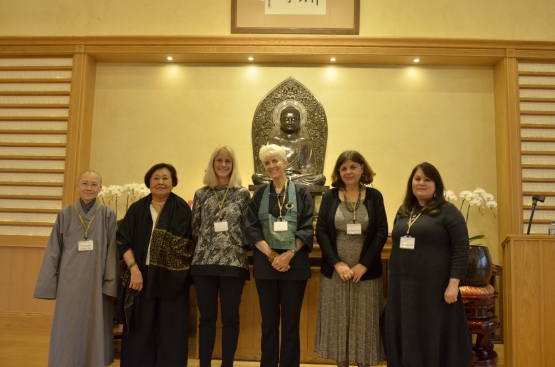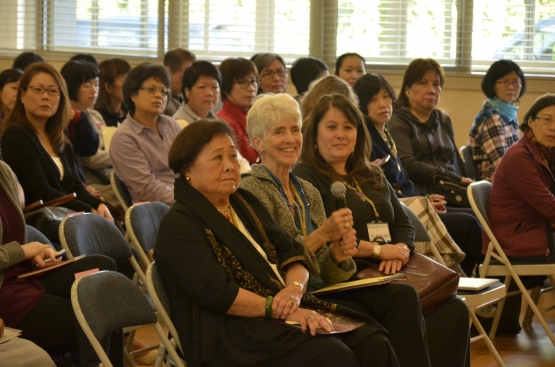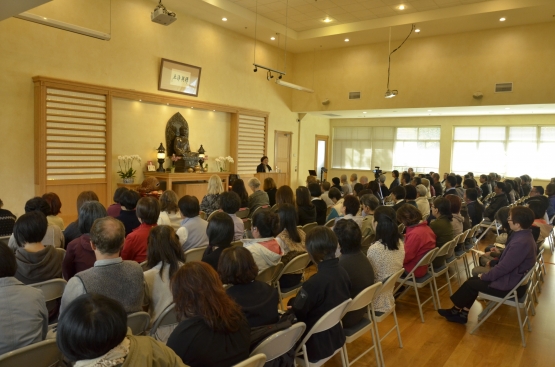
By Lisa Su
Speakers from various institutions around North America congregated at the Dharma Drum Mountain Vancouver Center to hold an academic workshop on the topic of “Buddhist Women: Practitioners and Teachers, Past and Present.” These speakers were not only scholars, but also Buddhist practitioners, and were able to relate their experiences throughout the presentation.
The morning began with Professor Beata Grant, from the University of Washington in St. Louis, presenting on the topic of “Teacher, Traveler, and Loyalist: The Poems and Gathas of Female Chan Master Jizong Xingche.” Master Xingche lived in 17th century China and was a renowned Chan master of the Linji lineage in the Ming Dynasty. In her autobiography, she talked of her mother having a dream of an elderly monk coming to ask if he could stay for a while. Then, she was conceived and born.
Xingche had ideas of renouncing the home life at a young age, but her father opposed the idea, so she went along with the social norms of getting married and rearing kids. She had three children but, unfortunately, her husband died suddenly while travelling. He was involved in political movements, which were a cause of tensions at the time. After meeting Chan Master Tongji, she did a 49-day-and-night Huatou practice, where she had an enlightenment experience. She was then able to leave the home life to ordain, residing in the mountains of Nanyue and enjoying the life of a hermit. The beauty of the Nanyue mountains was mentioned many times throughout the Chan poems she wrote. After her master Tongji passed away, she went to pay visits to prominent masters. At the time, it was rather unprecedented for a female to travel such long distances, not only because of social norms but also because of safety reasons. Across the lands she journeyed on foot.
Upon arriving at Master Tongche’s place in the province of Jiangsu and having a Dharma conversation, Master Tongche was very impressed with Xingche and designated her to be one of his Dharma Heirs, making her a 32nd generation heir of the Linji lineage. This was when people began calling her Chan Master Xingche. She wanted to return to the recluse life in Nanyue, but Master Tongche insisted on her staying to teach the Dharma to help revitalize and reorganize the Linji School of Buddhism.
She had many followers, including nuns, laywomen, laymen, and earned the respect of fellow monks. Skillful in her teachings, she was able to inspire many laywomen to practice Huatou investigation, even at home. Notable monastic teachers at the time spoke highly of her and she corresponded with many of them. However, she was critical of unlearned monastic “teachers” who would utilize Linji’s shout and Deshan’s staff inappropriately, as if they were play-acting. She even wrote a poem commenting on this phenomenon. She was known for not paying heed to the fact that she was a female – she was stern in her teachings and also employed shouting and hitting during her teachings. At the height of her teaching period, she was the abbess of five nun convents and actively taught for 6 to 7 years in total.
Afterwards, Master Xingche returned to the mountains of Nanyue and resettled near where Master Tongji passed away, where she spent the last known days of her life. Not much is recorded in history regarding her life after she returned there. However, she left behind a rich collection of poems that were not only inspiring and elegant, but also sometimes straightforwardly blunt. Chan Master Xingche is an example of a female Chan master who made her mark in Buddhist history.
Next, Professor Chun-Fang Yu of Columbia University presented her research on “Buddhist Nuns in Contemporary Taiwan,” tackling the issue of modern female monastic organizations.
She began her talk with some statistics, stating that there is currently a 4:1 ratio of nuns to monks in the Taiwan monastic community. This large number was unprecedented in Buddhist history. What was special about the nuns in Eastern Buddhism is that the lineage of nuns has been unbroken since the 5th century, unlike the Theravada and Tibetan traditions where the female monastic lineage was lost in transmission. If there were no previously-ordained nuns to be found due to the lost lineage, then no new women could ordain because ordination ceremonies require previously-ordained nuns. In Eastern Buddhism’s very long lineage, there have only ever been two written works dedicated to the topic of nuns, one written in ~500 AD, and the other written in modern times, recording the biographies of nuns. Female monasticism was not only scarcely-documented throughout history, but this flourishing of female monasticism was also only recently found.
In 1987, there were a great number of Buddhist organizations, Buddhist universities, and Buddhist monasteries being founded in Taiwan. Along with that, there was a focus on Buddhist engagement in society, which led to coining the phrase “humanistic Buddhism.” Universities had Buddhist clubs or Buddhist societies, which did a lot to promote Buddhism and attract young talent into the monastic order. With greater access to education for the general public and a booming economy in Taiwan, many women had the choice to not marry, which was counter to the expected norm, and instead enter the monastic life. Many nuns had higher education and careers in their lay lives, but did not choose the married life. Along with the rise in education among the female population, there was also a traditional expectation for males to carry on their family names. The sons were the heirs of the family and also had military service obligations. These conditions, particularly parental pressure, entailed that males were discouraged from entering the monastic order. Men who ordained had to take leave from the robes in order to serve out their mandatory military service; by the time they exited the military, they were of marriage age and would often then follow the social norms of lay life, either by choice or due to continuing pressure. These social dynamics are what led to the current female-to-male monastic ratio and the many many organizations that nuns joined or helped establish.
 One such organization was the Luminary (Incense Light) Buddhist Institute in Taiwan, which offered courses on Buddhism to the general public as a way to socially engage as part of the humanistic Buddhism effort. They were not the only organization to do so. With advances in technology, new forms of media opened up for sharing Dharma to a wider audience, including videos, recordings, and broadcasts.
One such organization was the Luminary (Incense Light) Buddhist Institute in Taiwan, which offered courses on Buddhism to the general public as a way to socially engage as part of the humanistic Buddhism effort. They were not the only organization to do so. With advances in technology, new forms of media opened up for sharing Dharma to a wider audience, including videos, recordings, and broadcasts.
There are many questions that remain. For instance, would a downturn in the economy have caused a downturn in females pursuing monasticism? Also, is the current format of attempting to reach a wide audience by engaging in humanistic Buddhism going to produce high-level practitioners like the great masters and great laypersons seen throughout history? Or will it generate a large number of general persons who just know and study Buddhism, and not create the conditions to allow some to blossom into the great sages and saints that we have come to venerate? These are questions to which the answers can only be found with time.
The next speaker was Professor Paula Arai of Louisiana State University, who presented on “Leaders & Healers: Women and Japanese Buddhism.”
In Professor Arai’s talk, the audience was introduced to a very different form of Buddhism that has had to adapt to Japanese culture. Females traditionally held a lower status there, and this extended to the monastic structure as well. At the beginning of the Soto Zen tradition, there was no respect for nuns and they faced structural oppression and very unequaltreatment. Led by a female monastic named Kojima, a battle was fought to gain the recognition that nuns deserved. They petitioned to gain the right to attend a Soto Zen education institution that the males already enjoyed. Their argument was that the institution’s rules were in contradiction of the Dharma, as the institutional rules sought to keep females inferior and subordinate to the males. They succeeded and Kojima was among the first to go complete her education at the institution. It was in 1952 that the sect awarded Kojima in recognition for her achievements.
In addition to the struggles of female monastics, laywomen also had struggles. Laywomen often did not have much time to go to temples or do long practices; instead, many Buddhist rituals served as their gateway to connecting with their faiths. Bowing was one of the prominent Buddhist rituals in household Japan, and many Buddhist women would erect a family altar at home, where they would pay respects not only to Buddhist figures but also to their ancestors. The bowing and rituals that they did at home provided a conduit for healing, empowerment, harmony, comfort, strength, transformation, expression, and spiritual connection.
Professor Arai’s research into these women left us with a much better understanding of the Buddhist female lay practitioner in Japan.
The day’s final talk was presented by Susan Moon, an experienced author and Dharma teacher in the Japanese Zen tradition in America. She presented three examples of female teachers there, and emphasized the importance of having female teachers in Buddhism. She gave a personal example about her first retreat. She was struggling in her meditation, but during a Dharma talk, where the teacher spoke of a 9th century female Chan master, Susan was inspired to persevere and overcome the challenges. Hearing that there were also accomplished female practitioners brought tears of relief to her eyes, and she resolved to continue her efforts, because, “If this Chan master, she could do it, so could I!”
Susan’s recent book on the topic of Buddhist women became one of its publisher’s bestsellers. Evidently, there is significant interest in women in Buddhism. She used the example of how people would like to hear about stories of their grandmothers too, and not just of their grandfathers.
The day concluded with a wrap-up discussion led by Professor Wendi Adamek from the University of Calgary. Many thought-provoking questions were asked by the audience, including the focus on lineages, Buddhism in the West, the obstacles of a beginner practitioner, and Buddhist sects in Japan. The panel of academic scholars, as well as the Venerables in attendance, provided excellent insights. A good exchange of perspectives and fruitful discussions were had. The day ended with a resounding applause from the audience, who now had a much greater understanding of past and present Buddhist women.